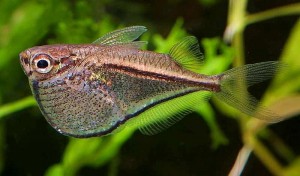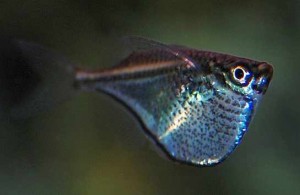The Blackwing Hatchetfish (Carnegiella marthae) is also known to tropical fish keeping enthusiasts as the Marthae Silver Hatchet.
It is found locally in ‘ Caño de Quiribana, near Caicara, Venezuela and is thought to range throughout the upper Orinoco drainage in Venezuela and the rio Negro drainage in Amazonian Brazil with occasional specimens collected from the rio Madeira. It may also occur in Columbia in the Rio Vichada and Rio Inirida tributaries.
Blackwinged Hatchetfish have convex bodies with a deep ventral profile. Their anal fin is set back and their wing like pectoral fins often extend to half of the fish’s body length. Their general body color is silver with black patches and stripes covering most of the body, and they have a gold stripe that stretches horizontally from the gill cover to the base of the tail. This species of hatchetfish grows to around 1 1/2″ in length.
The Blackwing Hatchetfish is usually found in small shoals in slow moving to stagnant blackwater environments characterized by thick, overhanging, riparian vegetation and substrates covered with tree roots, fallen branches, and leaf litter.
Because they are such a gregarious species, they should be housed with at least 12 or more of their own
kind in an aquarium environment.
Blackwing Hatchetfish make excellent candidates for a South American blackwater biotope setup. They need a tank with a lot of surface area and a dark sand or fine gravel substrate that is densely planted and covered with leaf litter to maintain the tannin level. Some driftwood or bogwood along with some floating plants
should be added to keep the fish from jumping and to provide a location for spawning.
Driftwood roots, branches and leaf litter will also produce colonies of beneficial microbes that act as a valuable secondary food source for the fry and protect the fish from disease.
Blackwing Hatchetfish require excellent water quality, a tightly fitting aquarium cover to keep them from “flying” out of the tank, and a power head to provide some water movement to keep them healthy. They are extremely sensitive to inferior water quality conditions.
Although the Blackwing Hatchetfish is a very peaceful species; because of its rather timid nature and small size, it does not make an ideal community tank fish.
When kept in a community environment, they should only be housed with like sized peaceful characids, dwarf cichlids (like Apistogramma spp.), and smaller callichthyid or loricariid catfish.
Although it is suscepted that Blackwing Hatchetfish breed like Marbled Hatchetfish (Carnegiella strigata), no successful breeding has ever been documented in an aquarium environment.
In their natural habitat, Carnegiella marthae are primarily a predatory species that feed on terrestrial and aquatic invertebrates and other zooplankton, at or near the surface of the water. In an aquarium environment, they will accept dried flake foods, micro pellets, and freeze dried bloodworms or tubifex, however they should also be given frozen or live daphnia, brine shrimp, baby crickets, Drosophila fruit flies
, mosquito larvae, and any other insects that might be available.
Blackwing Hatchetfish are commonly available to tropical fish keeping enthusiasts when they are 1″ to 1 1/2″ in size.
Minimum Tank Size: 20 gallons
Care Level: Moderate
Temperament: Peaceful
Water Conditions: 73-81° F, KH 2-4, pH 5.5-6.5
Max. Size: 2”
Color Form: Silver, Black, Orange, Red, Tan
Diet: Carnivore
Compatibility: Excellent in peaceful community tanks
Origin: Venezuela
Family: Gasteropelecidae
Lifespan: 5 years
Aquarist Experience Level: Advanced



